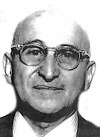Beno Gutenberg
Beno Gutenberg (also: Benno , born June 4, 1889 in Darmstadt , Germany ; † January 25, 1960 in Pasadena , USA ) was a German seismologist whose life's work made a decisive contribution to today's understanding of earth structure.
Life
Gutenberg first studied in Darmstadt and moved to Göttingen in 1908 with the aim of studying meteorology . Here he heard lectures from Emil Wiechert , who had recently established the Institute for Geophysics . At Wiechert, Gutenberg received his doctorate in 1911 with a seismological thesis. Two years later, Gutenberg determined the radius of the earth's core from seismological studies . His calculation is still considered exact today. The core-mantle boundary is therefore also called Wiechert-Gutenberg discontinuity , especially in the older literature .
Gutenberg became an employee of the International Seismological Association in Strasbourg . During the First World War he served as a meteorologist with the troops and was wounded. After the end of the war, Gutenberg returned to Strasbourg, but later moved to Frankfurt am Main , where he became an associate professor in 1926 . Before that, he was one of the founding members of the Germans founded on September 19, 1922 in Leipzig , along with Karl Erich Andrée , Gustav Angenheister , Immanuel Friedländer , Franz Kossmat , Gerhard Krumbach , Karl Mack , Ludger Mintrop , Peter Polis , August Heinrich Sieberg and Emil Wiechert Seismological Society , today's German Geophysical Society.
In the following years Gutenberg published a large number of scientific papers. Although he was already world-famous and the leading seismologist in Germany, he did not succeed in obtaining a full professorship. After his father died, Gutenberg earned his living as managing director of his father's soap factory in Darmstadt. There are indications, especially in connection with an appointment procedure for the successor of his doctoral supervisor Emil Wiechert in Göttingen in 1928, that his Jewish origins played a role, as the professors there feared that the number of Jews on the teaching staff would be too high.
Employment in Pasadena
In 1929 Gutenberg visited the seismological laboratory in Pasadena, USA, to which he moved a year later. He received the professorship for geophysics at the California Institute of Technology (Caltech), into which the seismological laboratory was integrated in 1936. In 1947 Gutenberg became director of the laboratory, which under his leadership played a central role in the study of earthquakes and the deep structures of the earth.
Together with Charles Francis Richter , he worked out the connection between the energy release of an earthquake and its magnitude: the Gutenberg-Richter scale , mostly referred to as the Richter scale . Gutenberg also discovered the zone of low velocities in the upper mantle, now known as the asthenosphere . The boundary between the lithosphere and the asthenosphere is therefore also known as the Gutenberg discontinuity . In 1945 he developed the sky wave magnitude scale and the surface wave magnitude scale for measuring earthquake magnitudes , and in 1956 together with Charles Francis Richter the unit magnitude scale as a combination of both.
Beno Gutenberg retired in 1958, but continued his research. He died on January 25, 1960 at the age of 70 of severe pneumonia as a result of a flu infection.
In honor and in memory of the researcher, the European Geosciences Union (EGU) awards the Beno Gutenberg Medal named after him .
Trivia
The first time that Gutenberg personally experienced an earthquake was on March 9, 1933, during the Long Beach earthquake in California, which he did not notice because he was talking to Albert Einstein on the Caltech campus at the time .
Awards and honors
- 1945 member of the National Academy of Sciences
- 1947 Foreign member of the Accademia Nazionale dei Lincei
- 1950 Lagrange Prize from the Royal Belgian Academy
- 1950 member of the American Academy of Arts and Sciences
- 1953 William Bowie Medal from the American Geophysical Union
- 1956 Emil Wiechert Medal of the German Geophysical Society
The Gutenberg Glacier in Antarctica has been named after him since 2003 .
Publications (selection)
- The seismic ground unrest and its connection with the neighboring areas, especially geology and meteorology , Berlin 1924.
- The structure of the earth , Berlin 1925
- Basics of earthquake science , Berlin 1927
- Seismicity of the Earth , together with Charles Francis Richter, New York 1941
- Physics of the earth's interior , New York 1959
literature
- Helmut E. Landsberg : Gutenberg, Beno. In: New German Biography (NDB). Volume 7, Duncker & Humblot, Berlin 1966, ISBN 3-428-00188-5 , p. 339 ( digitized version ).
Web links
- Literature by and about Beno Gutenberg in the catalog of the German National Library
- Short biography
swell
- ^ Leon Knopoff: Beno Gutenberg (biography in the online archive, National Academy of Sciences, Washington DC, USA)
- ↑ Knopoff, obituary for Gutenberg in the Biogr. Memoirs Nat. Acad.
| personal data | |
|---|---|
| SURNAME | Gutenberg, Beno |
| BRIEF DESCRIPTION | German-American seismologist and geophysicist |
| DATE OF BIRTH | June 4, 1889 |
| PLACE OF BIRTH | Darmstadt , Hessen , Germany |
| DATE OF DEATH | January 25, 1960 |
| Place of death | Pasadena , USA |
